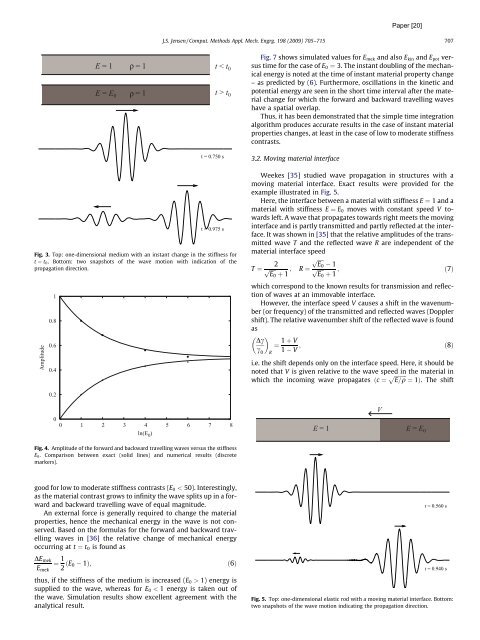WAVES AND VIBRATIONS IN INHOMOGENEOUS STRUCTURES ...
WAVES AND VIBRATIONS IN INHOMOGENEOUS STRUCTURES ...
WAVES AND VIBRATIONS IN INHOMOGENEOUS STRUCTURES ...
You also want an ePaper? Increase the reach of your titles
YUMPU automatically turns print PDFs into web optimized ePapers that Google loves.
good for low to moderate stiffness contrasts (E0 < 50). Interestingly,<br />
as the material contrast grows to infinity the wave splits up in a forward<br />
and backward travelling wave of equal magnitude.<br />
An external force is generally required to change the material<br />
properties, hence the mechanical energy in the wave is not conserved.<br />
Based on the formulas for the forward and backward travelling<br />
waves in [36] the relative change of mechanical energy<br />
occurring at t ¼ t0 is found as<br />
DEmek<br />
¼ 1<br />
2 ðE0 1Þ; ð6Þ<br />
Emek<br />
E = 1 ρ = 1<br />
E = E0 ρ = 1<br />
t < t 0<br />
t > t 0<br />
t = 0.750 s<br />
t = 0.975 s<br />
Fig. 3. Top: one-dimensional medium with an instant change in the stiffness for<br />
t ¼ t0. Bottom: two snapshots of the wave motion with indication of the<br />
propagation direction.<br />
Amplitude<br />
1<br />
0.8<br />
0.6<br />
0.4<br />
0.2<br />
0<br />
0 1 2 3 4<br />
ln(E0 )<br />
5 6 7 8<br />
Fig. 4. Amplitude of the forward and backward travelling waves versus the stiffness<br />
E0. Comparison between exact (solid lines) and numerical results (discrete<br />
markers).<br />
thus, if the stiffness of the medium is increased (E0 > 1) energy is<br />
supplied to the wave, whereas for E0 < 1 energy is taken out of<br />
the wave. Simulation results show excellent agreement with the<br />
analytical result.<br />
J.S. Jensen / Comput. Methods Appl. Mech. Engrg. 198 (2009) 705–715 707<br />
Fig. 7 shows simulated values for Emek and also Ekin and Epot versus<br />
time for the case of E0 ¼ 3. The instant doubling of the mechanical<br />
energy is noted at the time of instant material property change<br />
– as predicted by (6). Furthermore, oscillations in the kinetic and<br />
potential energy are seen in the short time interval after the material<br />
change for which the forward and backward travelling waves<br />
have a spatial overlap.<br />
Thus, it has been demonstrated that the simple time integration<br />
algorithm produces accurate results in the case of instant material<br />
properties changes, at least in the case of low to moderate stiffness<br />
contrasts.<br />
3.2. Moving material interface<br />
Weekes [35] studied wave propagation in structures with a<br />
moving material interface. Exact results were provided for the<br />
example illustrated in Fig. 5.<br />
Here, the interface between a material with stiffness E ¼ 1 and a<br />
material with stiffness E ¼ E0 moves with constant speed V towards<br />
left. A wave that propagates towards right meets the moving<br />
interface and is partly transmitted and partly reflected at the interface.<br />
It was shown in [35] that the relative amplitudes of the transmitted<br />
wave T and the reflected wave R are independent of the<br />
material interface speed<br />
pffiffiffiffiffi<br />
2<br />
E0 1<br />
T ¼ p ; R ¼ p ; ð7Þ<br />
þ 1 þ 1<br />
ffiffiffiffiffi<br />
E0<br />
ffiffiffiffiffi<br />
E0<br />
which correspond to the known results for transmission and reflection<br />
of waves at an immovable interface.<br />
However, the interface speed V causes a shift in the wavenumber<br />
(or frequency) of the transmitted and reflected waves (Doppler<br />
shift). The relative wavenumber shift of the reflected wave is found<br />
as<br />
Dc<br />
c 0 R<br />
1 þ V<br />
¼ ; ð8Þ<br />
1 V<br />
i.e. the shift depends only on the interface speed. Here, it should be<br />
noted that V is given relative to the wave speed in the material in<br />
which the incoming wave propagates ðc ¼ ffiffiffiffiffiffiffiffi p<br />
E=q ¼ 1Þ. The shift<br />
E = 1 E = E 0<br />
V<br />
t = 0.560 s<br />
t = 0.940 s<br />
Fig. 5. Top: one-dimensional elastic rod with a moving material interface. Bottom:<br />
two snapshots of the wave motion indicating the propagation direction.

















